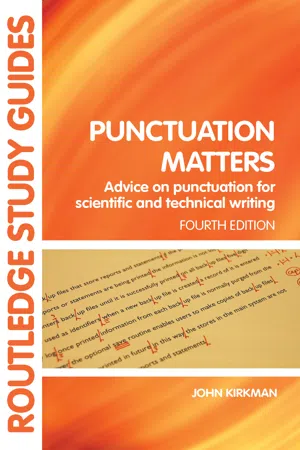![]()
Part 1
Policy
Stops should be used as sparingly as sense will permit: but in so far as they are needed for an immediate grasp of the sense or for the avoidance of any possible ambiguity, or occasionally to relieve a very lengthy passage, they should be used as freely as need be. The best punctuation is that of which the reader is least conscious; for when punctuation, or the lack of it, obtrudes itself, it is usually because it offends.
G. V. Carey, Mind the Stop [p22]
Difficulties caused by lack of punctuation
Time and again, as I read scientific and technical texts, I am obliged to go back and re-read stretches of words. My difficulty is not caused by unfamiliar terms: I have to re-read because writers do not show where units of meaning are supposed to begin and end.
Consider the following extract. I had to read it twice before I was able to interpret it correctly. Do you have to do the same, and if so, why?
Most people begin to interpret that sentence as a statement about a machine developing some forms; but then they have to adjust their understanding as they progress further along the lines. No doubt you can see the cause of disturbance. If the writer had provided a comma after the preliminary word-group, you would not have had to stop and re-read the extract:
Here is another extract, which causes difficulty for readers in a different way:
To read that comfortably (and without a smile at the ambiguity), we need a comma before and quotes Freud:
You may be surprised by the suggestion that a comma should be put before and. Teachers of English seem to have left many people with a feeling that it is a cardinal sin to do such a thing. There are some circumstances in which a comma is not needed before and, and some in which it is. That point is discussed fully in Part 2, page 46.
The next example illustrates a third type of difficulty caused when a writer carelessly omits punctuation:
As written, this statement implies that there are some production documents that are commercially confidential, and some that are not. We interpret the statement in that way because there is no comma between documents and the word-group which are commercially confidential. Unfortunately, the writer wanted to imply that all production documents are commercially confidential. He should have signalled this by inserting a comma after documents:
This example is important. It shows how relationships between words in a statement are signalled both by the presence and by the absence of punctuation marks. We use word-groups beginning with which either to define or to comment, and the precise function is signalled to the reader by the presence or the absence of a comma. That point is discussed fully in Part 2, pages 38 to 42.
For a fourth illustration of how faulty punctuation causes discomfort and ambiguity in technical writing, here is an example of careless omission of hyphens:
That sentence seems to make sense: but I discovered from discussions with the writer that he intended to say:
In revising all these examples, I have not invented revolutionary policies or practices: I have simply introduced signals, punctuation marks, in accordance with established conventions of English. If the writers had used those signals, I should not have had to struggle to make out the meanings they wished to communicate.
The jobs done by punctuation marks
Punctuation marks are integral parts of the signalling system we call writing. They do two jobs. One is grammatical and the other is rhetorical:
• grammatical: they show where the boundaries are meant to be between segments of larger statements, and how segments of text are meant to relate to one another;
• rhetorical: they show the emphasis or tone we want to give to a word or word-group.
Here is an example that illustrates the boundary-marking role:
Did you mis-read that statement at first? The first time I read it, I read Because of this action as a group; but then I realised that the group at the beginning of the second sentence was intended to be just Because of this. If the writer had supplied a comma at the meaning-boundary between this and action, I should not have been misled:
Note how punctuation marks signal the relations between segments of text in the following statements:
The words in the two statements are exactly the same, but the relations between the words change in accordance with whether a comma is present or absent.
The next three examples illustrate the rhetorical job done by punctuation marks. Note how they signal the emphasis or tone we want to give a word or word-group – information which, if we were speaking, we would express by inflections of voice:
As all these examples show, punctuation marks (including the use of capital letters, underlining, and italics) are vital parts of our signalling system. They are not just optional extras.
Let me emphasise again that it is not just the presence of a punctuation mark that signals something to a reader. In the Take no action … examples, the absence of a comma was as significant as the presence of a comma.
We must not, therefore, include or omit punctuation marks on grounds of appearance. The remark ‘Too many stops and commas make the text look spotty’ ignores the proper function of punctuation. (Yes, that remark was offered in a discussion of effective writing during one of my courses!)
The following text is far from ‘spotty’: it ...
